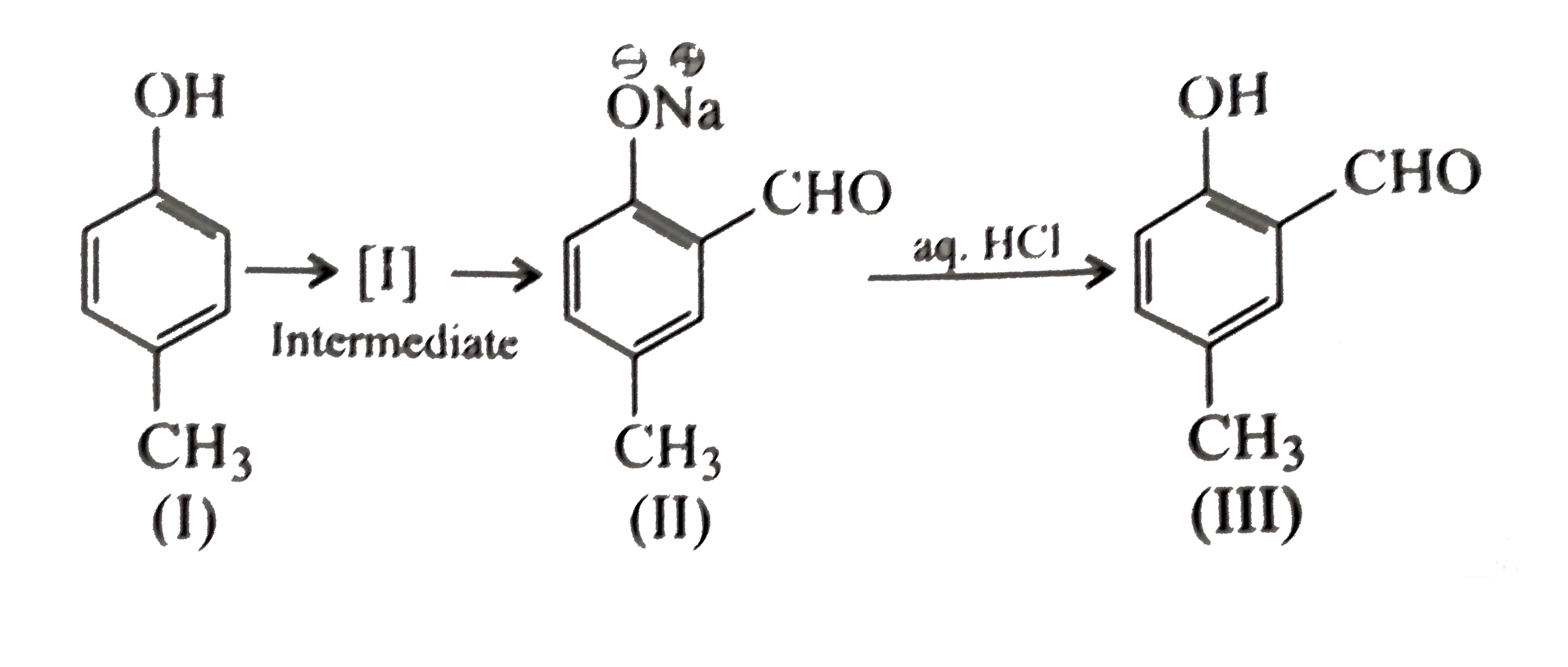Reimer -Tiemann reaction involves a
Carbonium ion intermediate
Carbene intermediate
Carbanion intermediate
Free radical intermediate
The correct Answer is:B
Step-by-Step Solution:
1. Understanding the Reaction: The Reimer-Tiemann reaction involves the reaction of phenol with chloroform (CHCl₃) in the presence of a strong base, typically sodium hydroxide (NaOH) or potassium hydroxide (KOH). This reaction leads to the formation of salicylaldehyde.
2. Initial Setup: Begin with phenol (C₆H₅OH) and add it to a solution of a strong base (NaOH or KOH) along with chloroform (CHCl₃). The base deprotonates the phenol, forming a phenoxide ion (C₆H₅O⁻).
3. Formation of Carbene: The chloroform reacts with the hydroxide ion to produce a carbene intermediate. The chlorine atoms in chloroform are electron-withdrawing, making the carbon atom more electrophilic. The hydroxide ion attacks the carbon of chloroform, leading to the release of chloride ions and the formation of a carbene (C=CH₂).
4. Nucleophilic Attack: The phenoxide ion, which is now negatively charged, acts as a nucleophile and attacks the carbene. This results in the formation of a new carbon-carbon bond.
5. Formation of Salicylaldehyde: After the nucleophilic attack, rearrangements occur, and water is eliminated from the intermediate. This leads to the formation of salicylaldehyde (C₇H₆O₂), which contains both a hydroxyl group (OH) and an aldehyde group (CHO) on adjacent carbon atoms.
6. Conclusion: The Reimer-Tiemann reaction involves the formation of a carbene intermediate, which is crucial for the reaction mechanism.
Final Answer:
The Reimer-Tiemann reaction involves a carbene intermediate.
---
The Reimer-Tiemann reaction involves a carbene intermediate.
Topper's Solved these Questions
- BOOK - VMC MODULES ENGLISHCHAPTER - ALDEHYDES,KETONES & CARBOXYLIC ACIDS EXERCISE - IN-CHAPTER EXERCISE-K10videos
ALDEHYDES,KETONES & CARBOXYLIC ACIDS
- BOOK - VMC MODULES ENGLISHCHAPTER - ALDEHYDES,KETONES & CARBOXYLIC ACIDS EXERCISE - IN-CHAPTER EXERCISE-L10videos
ALDEHYDES,KETONES & CARBOXYLIC ACIDS
- BOOK - VMC MODULES ENGLISHCHAPTER - ALDEHYDES,KETONES & CARBOXYLIC ACIDS EXERCISE - IN-CHAPTER EXERCISE-I10videos
ALDEHYDES,KETONES & CARBOXYLIC ACIDS
- BOOK - VMC MODULES ENGLISHCHAPTER - ALCOHOLS, PHENOLS & ETHERSEXERCISE - Impeccable100videos
ALCOHOLS, PHENOLS & ETHERS
- BOOK - VMC MODULES ENGLISHCHAPTER - AMINESEXERCISE - IN CHAPTER EXERCISE H10videos
AMINES
Similar Questions
Knowledge Check
- Question 1 - Select One
Phenol gives Reimer Tiemann reaction with :
ACHCl3BCCl4CCHCl3andCCl4DC6H5CHCl
Reimer-Tiemann reaction introduces an aldehyde group on to the aromatic ring of phenol, ortho to the hydroxyl group. This reacrtion involves electrophilic aromatic subsititution. It is a general method for the synthesis of subsituted salicyladehydes as depiced below:

The electrophile in this reaction is:View SolutionReimer-Tiemann reaction introduces an aldehyde group on to the aromatic ring of phenol, ortho to the hydroxyl group. This reacrtion involves electrophilic aromatic subsititution. It is a general method for the synthesis of subsituted salicyladehydes as depiced below:

Which one of the following reagents is used in the above reaction ?View SolutionThe electrophile involved in the Reimer-Tiemann reaction is
View SolutionIn Reimer - Tiemann reaction the major produc is
View SolutionWrite the equations involved in the following reactions:
(i) Reimer - Tiemann reaction (ii) Kolbe’s reactionView SolutionThe structure of the intermediate formed in the Riemer Tiemann reaction is :
View SolutionWrite the equation involved in the following reaction :
(i) Reimer -Tiemann reaction
(ii) Williamson synthesisView Solution
